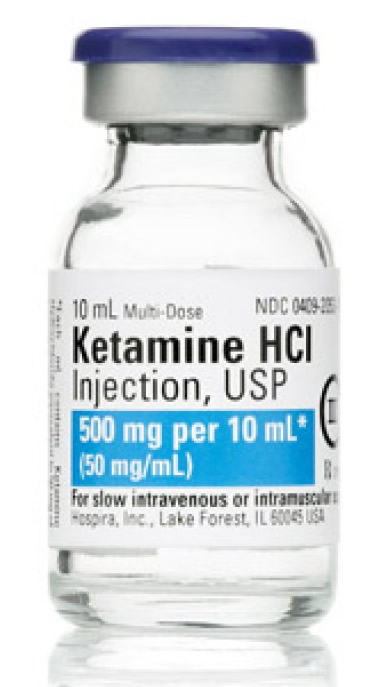Virtual Drug Bag
|
KETAMINE |

PACKAGED: 500 mg/10 mL (50 mg/ml)
LOCATION: Intermediate Controlled Drug Pocket
INDICATIONS:
- Chemical restraint for combative patient, including Excited Delirium
- Sedation prior to Rapid Sequence Intubation
ADULT:
- {Sedate to intubate, rapid sequence intubation: 100 mg (2 mL) administer slow IV.} Repeat IV at 5 minutes.
- Combative patient including those with excited delirium:
250 mg IM administered in anterolateral thigh, wait 2 minutes, if desired effect is not achieved, repeat 250 mg IM opposite leg.
Or 100 mg slow IV.
After 10 minutes and an additional drub bag is available, may repeat 250 mg IM, wait 2 minutes if desired effect is not achieved, repeat 250 mg IM opposite leg.
Or repeat 100 mg slow IV.
PEDI:
- Limited to use in patients age 8 or greater.
- Chemical restraint for combative patient, including Excited Delirium: 1 mg/kg slow IV (max dose 100 mg).
Or 5 mg/kg IM (max dose 500 mg, which is two doses of 250 mg)
PHARMOLOGIC EFFECTS
- Ketamine is a Schedule III Phencyclidine (PCP) derivative that is rapid acting and produces a “dissociative” anesthesia in which the patient’s consciousness is detached from their nervous system. Due to its “dissociative” properties, Ketamine is a potent analgesic.
- Minimal cardiac depression occasionally reported with high doses administered rapidly IV. May transiently increase heart rate and blood pressure by central sympathetic stimulation.
- Ketamine is a bronchodilator and causes minimal to no respiratory depression.
- Because it has a minimal effect on blood pressure, it has therapeutic advantages over many narcotics and sedatives in patients who are hypotensive.
- May be given as an adjunct to narcotic pain medication, particularly in patients at risk for hypotension or respiratory depression.
CONTRAINDICATIONS:
- Hypertensive Crisis
- When significant elevations in BP might prove harmful:
- Acute Myocardial Infarction, angina
- Aortic dissection
PRECAUTIONS AND SIDE EFFECTS:
- An emergence reaction may occur near end of medication half-life, when patient is awakening (hallucinations, delirium, confusion, excitement, irrational behavior)
- May require administration of midazolam or diazepam prior to wearing off.
- Catecholamine release (hypertension, tachycardia)
- Hypersalivation (the ketamine drool)
- Nausea, vomiting, particularly prevalent in pediatrics.
REQUIRES MCP:
ADULT: No PEDI: No
PEDI repeat: Yes
NOTE: Ketamine may not be used without approval of your Department Chief and Department Medical Director!
CLINICAL PEARLS
- ****HIGH ALERT: KETAMINE IS SUPPLIED IN 500 MG VIALS. YOU WILL NOT ADMINISTER THIS WHOLE VIAL IV. THERE IS A MAJOR DIFFERENCE BETWEEN DOSES IN CERTAIN INDICATIONS AND BY DIFFERENT ROUTES. CHECK YOUR MATH BEFORE YOU GIVE THIS DRUG.****
May re-medicate after 10 minutes as effects wear off.
Because of dissociative effect, patient may appear awake, with eyes open, though will not directly respond to stimuli.
Airway protective reflexes typically remain intact after administration, and Ketamine typically does not cause respiratory depression, which makes it appropriate for patients undergoing sedation who will not be intubated.

